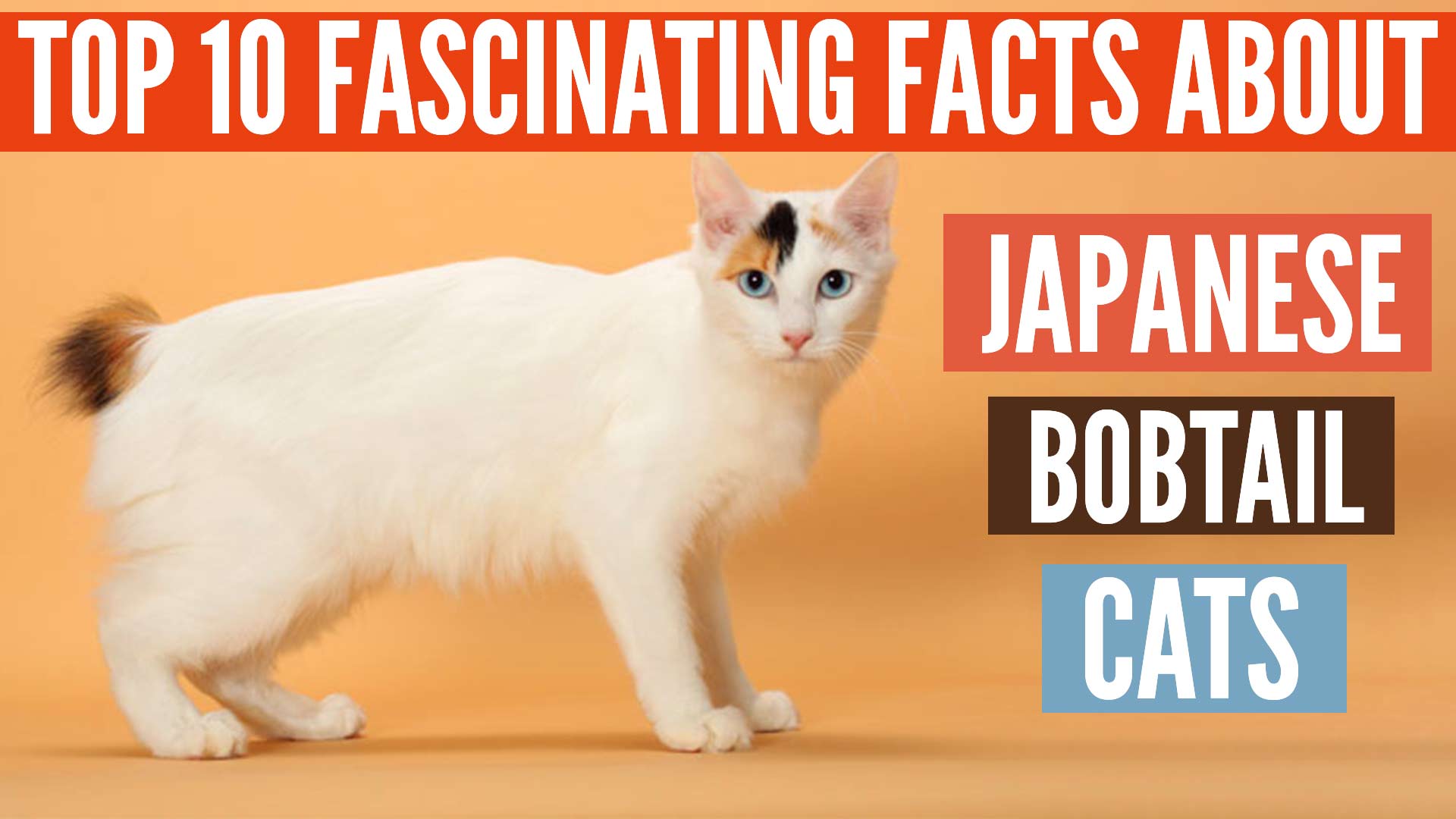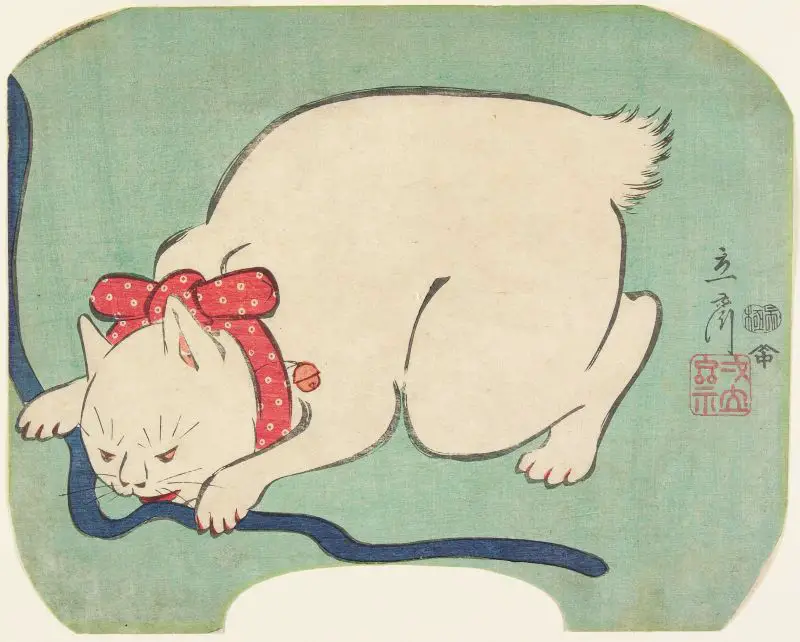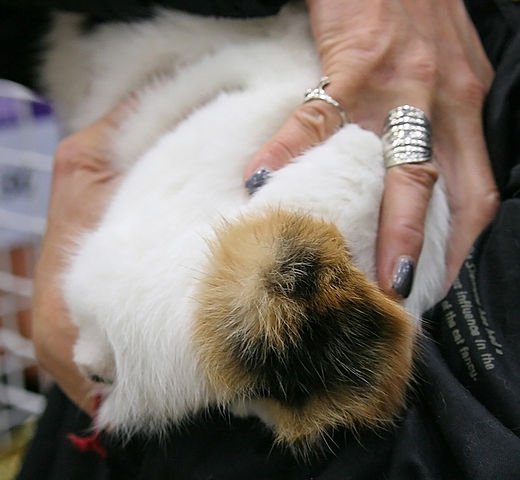An unusual little bobtail, cute equilateral face, round bright eyes, an active affectionate personality, and an overall playful nature makes owning a Japanese Bobtail cat every cat lover’s dream.
But that is not all that is there to know about these precious felines.
In this post, I am going to layout 10 fascinating facts about the Japanese Bobtail cats that will make you fall in love with them if you already aren’t.
Standing true to their names the Japanese Bobtail cats are believed to originate from the Land of the Rising Sun.
That being said, in a moment you will see that their genetics actually point to a very different origin story.
The Japanese bobtail cats have medium builds with the average cat weighing anywhere from 6 to 10 pounds.
The breed is native to Southeast Asia along with Japan, though now it can be found almost everywhere in the world.
As is the case with most breeds, the Japanese Bobtail cats can have any coloration or a mixture of colors arranged in a number of patterns.
Predominantly it is observed that the Japanese and cat lovers, in general, prefer white calicoes owing to its root in ancient Japanese folklore which we are going to learn in a moment.
Alright, now that I have created sufficient intrigue in you;
Let’s go ahead and look into 10 fascinating facts about the Japanese Bobtail cats that will leave you amazed.
- Do not forget to check out 30 incredible unknown facts about calico cats that will make you fall in love with them.
1. The Colorful Origin Story Of The Japanese Bobtail Cats
The Title Of Street Cats Of Japan
Cat lovers around the world believe that the Japanese Bobtail Cat is an ancient breed.
It is believed that it was the Buddhist monks who originally owned these felines.
In 1602, a sudden surge in the population of rodents threatened the nation’s silkworm population and the businesses associated with it.
With this in mind, the administration authorities decreed that all cats must be set free to help deal with the situation.
At that point in time, it was illegal to buy or sell cats in the country. Henceforth, the Japanese Bobtail cats started living on farms and streets of the country.
This is how the Japanese Bobtail cats became the “street cats” of Japan.
Mysterious Origin Of The Japanese Bobtail Cats
While this explains how the Japanese Bobtails became the de facto streets cats of Japan, their true origin still remains a mystery.
Scientists and researchers have recently discovered that the Japanese Bobtail cats aren’t genetically similar to other cats in Japan.
A team of researchers headed by Leslie Lyons, a scientist in the School of Veterinary Medicine at the University of California collected 22 DNA samples from 22 cat breeds across the world.
The conclusions from the findings in the Washington Post report that the Bobtails “either didn’t originate in Japan or there’s been so much Western influence that they have lost their initial genetic signal”.
There is also another very interesting belief that associates their origin to Buddhist monks.
Some people speculate that Japanese Bobtails cats may have been first originated in Asian countries like China or Korea.
When the Buddhist monks first arrived in Japan, they brought with them these cats to protect their rice paper scrolls from rats in their Buddhist temples.
Early Mentions Of The Japanese Bobtail Cats
So as you can see nobody truly knows the origin of Japanese Bobtail cats.
However, what is true is the fact that the Japanese Bobtail cats have been in Japan for at least several centuries.
This is attested by an early mention of the Japanese Bobtail cats in a book written by a German doctor named Engelbert Kaempfer in 1702 called the Kaempfer’s Japan.
The book goes in elaborate details about the animal ecosystem, plant life form and natural landscapes of Japan.
This book is believed to be the first of its kind to be ever written by a western author.
The book states and I quote, “There is only one breed of cat that is kept. It has large patches of yellow, black and white fur its short tail looks like it has been bent and broken. “
Kaempfer’s Japan
In addition to this, there are several artworks that have popped up over the centuries that depict the early presence of the Japanese Bobtail cats.
Check out this ancient painting designed by Hiroshige II, where a cute white bobtail is biting on a blue string.
Another one of the ancient Japanese paintings depicting a little girl with her mother playing with a bobtail.
All of this goes ahead to show that the details of the true origins of the Japanese Bobtail cats may be a little vague.
But it is evident that these cats have been a part of the Japanese culture for centuries.
2. Arrival Of The Japanese Bobtail Cats In The United States
While the Bobtails have been a part of the Japanese culture for decades, they only arrived in the United States in late 1968.
This happened when a cat breeder by the name Elizabeth Freret decided to import three Japanese Bobtail kittens.
She was very impressed when she saw a bobtail with a military service family that they brought back from Japan.
Another breeder also from the United States, Lynn Beck also started breeding Bobtail cats around the same time, thanks to her frequent visits to Japan.
Beck then established the first Japanese Bobtail based cat club.
After a while, Beck and Freret collaborated to write the first breed standard for the Japanese Bobtail Cats.
In 1976, Cat Fancier’s Association identified and accepted the breed for championship status and later in 1993 CFA identified a longhair version of the Japanese Bobtail Cats.
Today, the Japanese Bobtail cats are identified and recognized by almost all North American registries.
3. Japanese Bobtails Are Said To Bring Good Luck.
In our previous post on 30 amazing facts about calico cats, we discussed how calico cats are considered to bring good luck from ancient times.
It seems that is true with the Japanese bobtail cats as well.
Have you ever observed a cat figurine in various Asian stores and restaurants giving a wave at you calling you in?
The beckoning cat figurine or Maneki-Neko, is inspired by the sweet and charming Japanese Bobtail cats.
How cool is that?
Yet another reason to own them isn’t it?
The good luck factor is also attributed to the Japanese Bobtail cats because of their historical contribution to humanity.
As explained in the earlier section of the post, Japanese bobtail cats acted as the guardians of the grain supplies, rice scrolls in Buddhist temples and the lucrative silkworm business threatened by rodents.
It is for the collective good they have been doing to the humanity that has earned them the title of being Lucky and having a special place in everyone’s heart.
4. The Japanese Bobtail Cat Isn’t Similar To Other Short Tail Cats
The moment you look at a bobtail, you may immediately think, how are the Bobtails similar or different to other short tail breeds like the Manx or the American Bobtail?
While yes both of these cat breeds are a result of spontaneous genetic mutation, both of these breeds are fairly different.
The genetic framework in Manx cats is such that the gene is an incomplete dominant gene.
this means a kitten that inherits the Manx gene can very well be born with a full-length tail, a medium-size tail, a stub or no ail at all.
Japanese bobtail gene, on the other hand, are recessive and on an average the bobtails are around 3 inches in length.
In addition, more often than not Manx cats suffer from skeletal problems such as spinal Bifida and hip, pelvic and anal deformities.
In general, no such genetic deformities are reported in the Japanese Bobtail Cats.
It is also a widespread belief that the American shorthair (which is a relatively new breed) gene is a subset from the domain of Manx gene.
The length of their tails is half the size of a household cat but in comparison much longer than the short stub of a Japanese Bobtail.
5. Their Short Tails Are A Result Of A Genetic Mutation
If you take a good close look at the physical characteristics of JBTs you will see that their build is starkly different then other cats.
They are endowed with a slender body, strong hind legs, oval eyes, big ears and an equilateral triangle-shaped head.
But their short bobtail, of course, is the most distinguishing feature among all.
An interesting fact about their Bobtails, which more or less looks like a pom-pom, owing to its curves and kinks is, no two tails of these cats are same.
There is yet another legend associated with the JBTs, this time specific to their tails.
As per the legend the JBTs have a small tail because a long time back a sleeping cat’s tail caught fire.
The frightened cat ran all over the town and in doing so set fire to the entire town.
The emperor as a response passed a decree that said all cats should have their tails chopped off so that such an event doesn’t occur again.
Pretty dumb emperor if you ask me.
In truth, their short bobtails are a consequence of a natural genetic mutation.
The genetic trait is recessive which means the trait takes over a dominant trait if both males and females have the same trait.
So if two cats with short tails mate, their kittens will have them as well.
6. The Assumption That Japanese Bobtail Cats Are All Calicoes Is Wrong
In Japan, the Bobtails are mostly referred to as mi-ke which means triple fur or calico.
This has led to a belief that the JBTs are always calico cats.
By the way, Calico is not a breed but a coloration, find out 30 awesome calico facts like these on one of the most liked posts here.
Japanese Bobtail cats can come in all kinds of variety ranging from solid colors to bi-color to van (cats that have coloration limited only to head and tail while the rest of the body is white).
There are also short hair and long hair versions of JBTs, both these variations have little undercoats due to which they have a silky and tangle-free fur.
JBTs tend to have blueish or golden eyes but all eye coloration is accepted by the registries.
Many times you will also find bobtails having different color in each eye.
This trait in cats is called heterochromia.
7. Japanese Bobtail Cats Can “Sing”
Ok now listen to this.
Quite the opera singers aren’t they?
I am just kidding. Japanese bobtails are a very alert, attentive and cautious breed that notice a lot.
Their voices as you are listening are very sweet, soft and capable of expressing nearly a whole scale of tones.
This is probably why this belief exists that the Japanese Bobtail cats can sing.
And you know what I am very happy with this belief.
I am also going to keep it Lol :D.
8. The Japanese Bobtail Cats Are Great Jumpers
Now, who among you has already guessed why that is so?
If you give a good look at the body build of Japanese Bobtail cats you will observe that they have a very strong and muscular back leg profile.
These extra muscles provide them the ability to jump with a strong thrust.
And because of this JBTs can jump relatively long and high when compared with other breeds.
9. Japanese Bobtails Are Very Smart, Affectionate And Playful Cat Breeds
To add to the already great list of attributes, the Japanese Bobtail cats are among the most joyful, loving and active breeds that you can get your hands on.
During times when he or she is not singing, she will likely be playing about with her favorite toy, splashing her paw in your koi pond or absolutely destroying your toilet paper roll.
They like playing with water, relish a challenging puzzle toy and are very quick at learning tricks.
They like challenges to the extent that they will even walk on a leash if you make the process entertaining enough.
And when you are sitting you can expect these cats to snuggle up and be cozy on your lap.
10. These Cats Are A Great Match For Families With Kids
The Japanese Bobtail cats are one of the most affectionate and playful breeds that you will find.
They are great for families with kids because they tend to share the same bubbly energy levels that kids exude.
The JBTs are up for anything ranging from playing fetch to being dressed as a doll for tea parties and paraded around in a baby buggy.
Having said that the child and cat interaction under all circumstances must happen under supervision.
Make sure the children and the pet play nicely and not unconsciously pull or twist the cat’s ears and tail.
What is also incredible is that JBTs also gel well with cat-friendly dogs given their amiable and fearless disposition.
All these qualities added with the good luck factor makes the Japanese Bobtail cat an ideal pet that you can probably look forward to having.
Brilliant isn’t it?
So with that, I am at the end of this exhaustive list of Japanese bobtail cat facts that I am pretty sure made you fall in love with these precious beauties.
Do anyone of you own a JBT?. How has your experience been with owning one?
Is there anything else that you know and I might have missed. Don’t forget to comment that out in the comments section below.
Also do not forget to share this post among fellow cat lovers and family members.
I hope you take great care of yourselves and I will see you again very very soon.
Bye !!.









I have read so many posts about the blogger lovers howeverthis post is really a good piece of writing, keep it up.
Means a lot. Thank you 🙂